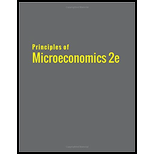
Classify the following as a government-enforced barrier to entry, a banker to entry that is not government-enforced, or a situation that does not involve a barrier to entry.
- A patented invention
- A popular but easily copied restaurant recipe
- An industry where economies of scale are very small compared to the size of demand in the market
- A well-established reputation for slashing prices in response to new entry
- A well-respected brand name that has been carefully built up over many years
(a)
The classification of the situation based on the given categories.
Answer to Problem 1SCQ
A patent invention is a government enforced barrier to entry.
Explanation of Solution
A patent is a legal assurance by the government which allows the patent holder an exclusive right to use the invention. It acts as barrier to entry as no one else other than the patent owner can reap the benefits of the invention unless the owner decides to sell it or lease it to another party.
Concept introduction:
Barrier to entry − The conditions or circumstances that prevent other firms from entering a particular industry are termed as barriers to entry. Such barriers can be either natural or government-enforced barriers.
Want to see more full solutions like this?
Chapter 9 Solutions
PRINCIPLES OF MICROECONOMICS (OER)
Additional Business Textbook Solutions
Managerial Accounting (5th Edition)
Horngren's Accounting (11th Edition)
Managerial Accounting (4th Edition)
Construction Accounting And Financial Management (4th Edition)
Horngren's Cost Accounting: A Managerial Emphasis (16th Edition)
Principles of Accounting Volume 1
- Monopolistic competition creates inefficiency because of the markups and excess capacity. The graph below depicts the situation for a hypothetical monopolistically competitive firm. The curves included in the graph are demand (D), marginal revenue (MR), average total cost (ATC), and marginal cost (MC). The graph is not graded, but you can move the point labeled P to help you find the numeric values to answer the questions. Price $ 80 MC M 45 P D ATC Quantity What is the size of the markup on the price? Number $0 What is the size of the excess capacity? Number Unitsarrow_forwardWhich of the following is not an example of an entry barrier? Group of answer choices Capital needed to start business. Government licensing or franchising. Low production costs. Strong brand recognition. All of the above are barriers to entry.arrow_forwardSupplier Set Price Versus Market-Determined Price: Collusion or Competition?arrow_forward
- Which of the following is not ever considered a cost of advertising from society's perspective? Decreased government revenue Waste of resources Misleading of vulnerable people Decreased competitionarrow_forwardAdvertising and Integrated Marketing Communications. Identify messages that you have seen or heard from several companies. Are the companies being consistent with their messages across the markets they are targeting? What factors are causing the media landscape to change? How can you maximize the reach of the promotional mix on a limited budget (that is, how can you get the most exposure for a minimal investment)?arrow_forwardpolicies government can have in place to increase perfect competition in the marketarrow_forward
- In which of the following situations would a company have a lower chance of losing customers when it raises the price of its product? a) There are low switching costs. b) Companies advertise their prices. c) Customers have many sellers to choose from. d) The product is differentiated across companies.arrow_forwardWhich of the following is not a barrier to entry? Group of answer choices high fixed costs ownership of a resource diseconomies of scale regulation and legal feesarrow_forwardAmazon company Describe anything that differentiates a product of your company, anything that generates barriers to entry and exit in your company, and any government policies that promote efficiency in your industry.arrow_forward
- Crowdsourcing affects new product development by: Group of answer choices: A) providing a controlled, exciting environment for the development of new product ideas. B) being a secretive process that helps to firm collect new ideas that other firms haven't seen. C) providing the company with ideas from a great many sources, including consumers. D) allowing inventors of novel technical products a way to promote their ideas.arrow_forwardA monopoly a)must have a patent to protect its products. b)is a price taker. c)produces the market output. d)doesn't lose any sales when it raises its price.arrow_forwardStudy the evolution of any brand/company of your choice regarding its target market. In addition, also discuss how the brand/company differentiate and position its products/services to get the maximum competitive advantagearrow_forward
 Managerial Economics: A Problem Solving ApproachEconomicsISBN:9781337106665Author:Luke M. Froeb, Brian T. McCann, Michael R. Ward, Mike ShorPublisher:Cengage Learning
Managerial Economics: A Problem Solving ApproachEconomicsISBN:9781337106665Author:Luke M. Froeb, Brian T. McCann, Michael R. Ward, Mike ShorPublisher:Cengage Learning Economics Today and Tomorrow, Student EditionEconomicsISBN:9780078747663Author:McGraw-HillPublisher:Glencoe/McGraw-Hill School Pub Co
Economics Today and Tomorrow, Student EditionEconomicsISBN:9780078747663Author:McGraw-HillPublisher:Glencoe/McGraw-Hill School Pub Co


 Economics (MindTap Course List)EconomicsISBN:9781337617383Author:Roger A. ArnoldPublisher:Cengage Learning
Economics (MindTap Course List)EconomicsISBN:9781337617383Author:Roger A. ArnoldPublisher:Cengage Learning





